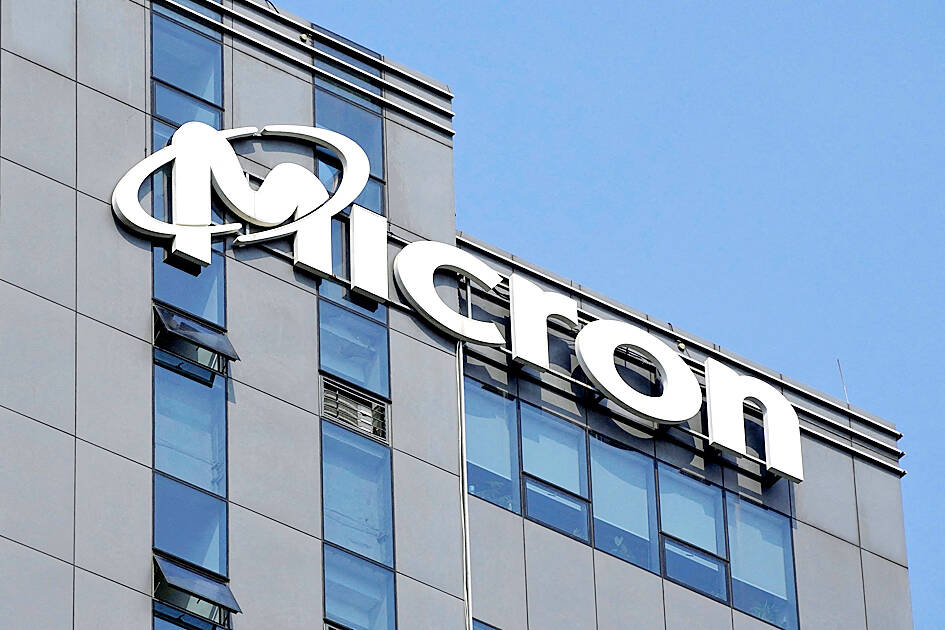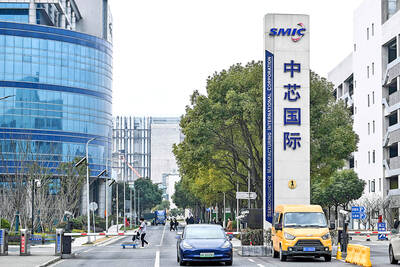Micron Technology Inc, the largest US maker of computer memory chips, is on track for its shares to rise by the most in six months after announcing surprisingly strong sales and profit forecasts, helped by demand for artificial intelligence (AI) products.
Fiscal first-quarter revenue would be about US$8.7 billion, the company said in a statement on Wednesday. That compares with an average analyst estimate of US$8.32 billion. Profit would be about US$1.74 a share, higher than a projection of US$1.52.
The rosy outlook is the latest sign that Micron is benefiting from a boom in AI spending. Orders for high-bandwidth memory have added a lucrative new revenue stream for the company and other chipmakers. The technology helps to develop AI systems by providing more rapid access to massive pools of information.

Photo: Reuters
Demand has been outpacing supply, allowing Micron to boost prices and secure long-term guaranteed contracts. It has already sold out of the product for this year and next year, the company said on Wednesday.
Micron shares rose by about 15 percent to US$110.60 in premarket trading on Thursday. If the gains hold, it would be the biggest intraday increase since March 21.
Results from Micron’s fiscal fourth quarter also handily beat estimates. Revenue increased by 93 percent year-on-year to US$7.75 billion for the period that ended Aug. 29. Excluding certain items, profit was US$1.18 per share. On average, analysts had estimated a profit of US$1.12 per share and revenue of US$7.66 billion.
Micron has an edge because it is the first chipmaker to reliably offer more advanced memory in high volumes, executive vice president of operations Manish Bhatia said in an interview.
With companies racing to beef up their AI software and hardware — and using more memory in the process — Micron is in a good position, he said.
The chipmaker is also emerging from a slowdown in demand for PCs and smartphones, two of the biggest markets for memory chips. Device shipments are now growing again. Those devices would increasingly feature AI functionality that requires more memory chips to work properly, adding a further benefit, Bhatia said.
Micron makes DRAM, a type of chip that temporarily holds information and works alongside processors from companies such as Nvidia Corp and Intel Corp. It also makes nand flash memory — semiconductors that store information in everything ranging from data-center computers to smartphones. The company competes with South Korea’s Samsung Electronics Co and SK Hynix Inc in the memory market.
“Robust AI demand drove a strong ramp of our data center DRAM products,” Micron chief executive officer Sanjay Mehrotra said in the statement.
“We are entering fiscal 2025 with the best competitive positioning in Micron’s history,” he said.

NO BREAKTHROUGH? More substantial ‘deliverables,’ such as tariff reductions, would likely be saved for a meeting between Trump and Xi later this year, a trade expert said China launched two probes targeting the US semiconductor sector on Saturday ahead of talks between the two nations in Spain this week on trade, national security and the ownership of social media platform TikTok. China’s Ministry of Commerce announced an anti-dumping investigation into certain analog integrated circuits (ICs) imported from the US. The investigation is to target some commodity interface ICs and gate driver ICs, which are commonly made by US companies such as Texas Instruments Inc and ON Semiconductor Corp. The ministry also announced an anti-discrimination probe into US measures against China’s chip sector. US measures such as export curbs and tariffs

The US on Friday penalized two Chinese firms that acquired US chipmaking equipment for China’s top chipmaker, Semiconductor Manufacturing International Corp (SMIC, 中芯國際), including them among 32 entities that were added to the US Department of Commerce’s restricted trade list, a US government posting showed. Twenty-three of the 32 are in China. GMC Semiconductor Technology (Wuxi) Co (吉姆西半導體科技) and Jicun Semiconductor Technology (Shanghai) Co (吉存半導體科技) were placed on the list, formally known as the Entity List, for acquiring equipment for SMIC Northern Integrated Circuit Manufacturing (Beijing) Corp (中芯北方積體電路) and Semiconductor Manufacturing International (Beijing) Corp (中芯北京), the US Federal Register posting said. The

India’s ban of online money-based games could drive addicts to unregulated apps and offshore platforms that pose new financial and social risks, fantasy-sports gaming experts say. Indian Prime Minister Narendra Modi’s government banned real-money online games late last month, citing financial losses and addiction, leading to a shutdown of many apps offering paid fantasy cricket, rummy and poker games. “Many will move to offshore platforms, because of the addictive nature — they will find alternate means to get that dopamine hit,” said Viren Hemrajani, a Mumbai-based fantasy cricket analyst. “It [also] leads to fraud and scams, because everything is now

MORTGAGE WORRIES: About 34% of respondents to a survey said they would approach multiple lenders to pay for a home, while 29.2% said they would ask family for help New housing projects in Taiwan’s six special municipalities, as well as Hsinchu city and county, are projected to total NT$710.65 billion (US$23.61 billion) in the upcoming fall sales season, a record 30 percent decrease from a year earlier, as tighter mortgage rules prompt developers to pull back, property listing platform 591.com (591新建案) said yesterday. The number of projects has also fallen to 312, a more than 20 percent decrease year-on-year, underscoring weakening sentiment and momentum amid lingering policy and financing headwinds. New Taipei City and Taoyuan bucked the downturn in project value, while Taipei, Hsinchu city and county, Taichung, Tainan and Kaohsiung